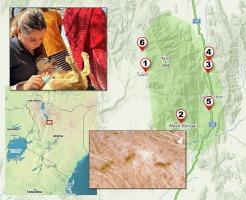Efficacy of oral afoxolaner (NexGard®) against natural infestations with Heterodoxus spiniger (Phthiraptera: Boopiidae) in dogs under field conditions
IF 1.4
Q3 PARASITOLOGY
Veterinary parasitology, regional studies and reports
Pub Date : 2025-07-11
DOI:10.1016/j.vprsr.2025.101316
引用次数: 0
Abstract
Heterodoxus spiniger is a chewing louse of a diverse range of hosts, primarily Carnivora. Domestic dogs are considered a major host, and infestations can lead to pruritus, hair loss, or seborrhea. In the context of absence of clinical trials evaluating the efficacy of isoxazolines against H. spiniger, the study aimed to assess the effectiveness of a single oral dose of afoxolaner (NexGard®, Boehringer Ingelheim, Germany) under field conditions for the treatment of natural infestations in dogs, and to compare it with a topical contact ectoparasiticide registered in Europe for the chewing lice Trichodectes canis (Frontline Combo®, Boehringer Ingelheim, Germany) based on fipronil and (S)-methoprene. The study was a field, blinded, positive-control, single-site clinical efficacy study that was performed around Mount Ng'iro, Kenya. Between 30th January and 4th February 2025, 36 dogs infested with H. spiniger were included in the study when brought by owners for a regular rabies vaccination. For each included animal one adult H. spiniger was identified microscopically and collected in absolute ethanol. After inclusion, each infested dog was randomly assigned to one of the two groups: group 1 (investigational group treated with NexGard®) group 2 (positive control group treated with Frontline Combo®). Clinical assessments were performed at inclusion (day 0), then at day 15 (±2) and day 30 (±2) when scoring and evaluation of the skin lesions and symptoms was done. A grading system was also applied for scoring the presence of H. spiniger. Overall, 36 dogs were included (16 in group 1 and 20 in group 2). Four dogs did not complete the study. On days 15 (±2) and 30 (±2), all 32 dogs (from the 2 study groups) scored 0 for lice (i.e. no nits, no alive lice). The primary outcome was the complete eradication of lice by day 30 (±2). During the duration of the study, no reinfestation due to the hatching of eggs was observed. After treatment, a statistically significant decrease in degree of hair loss, pruritus, scaling, and lice score was noticed in the two groups at days 15 (±2) and 30 (±2) compared to day 0. The results show a clinical efficacy of 100 % for oral afoxolaner (NexGard®) against Heterodoxus spiniger, as well as of the control product (Frontline Combo®).

口服阿伏菌素(NexGard®)在野外条件下对家犬刺毛异蚊(Phthiraptera: Boopiidae)自然侵害的防治效果
棘异虫是一种不同寄主的咀嚼虱,主要是食肉目。家狗被认为是主要的宿主,感染会导致瘙痒、脱发或皮脂漏。在缺乏临床试验评估异恶唑啉类药物对spiniger的有效性的情况下,本研究旨在评估单剂量口服阿福唑啉(NexGard®,勃林格殷格翰公司,德国)在野外条件下治疗狗的自然感染的有效性,并将其与在欧洲注册的用于犬咀嚼虱(Trichodectes canis)的局部接触性外寄生虫杀虫剂(Frontline Combo®,勃林格殷格翰公司,(德国)基于氟虫腈和(S)-甲基丁二烯。该研究是在肯尼亚Mount Ng’iro周围进行的一项现场、盲法、阳性对照、单点临床疗效研究。在2025年1月30日至2月4日期间,研究人员将36只感染了螺旋螺旋杆菌的狗纳入研究范围,这些狗是由主人带来定期接种狂犬病疫苗的。对每只纳入的动物进行显微镜鉴定,并在无水乙醇中收集。纳入后,将每只感染犬随机分为两组:1组(试验组使用NexGard®治疗)和2组(阳性对照组使用Frontline Combo®治疗)。在纳入时(第0天)进行临床评估,然后在第15天(±2)和第30天(±2)对皮肤病变和症状进行评分和评估。还采用了一种分级系统来对刺棘菌的存在进行评分。共纳入36只犬(1组16只,2组20只)。有四只狗没有完成这项研究。在第15(±2)天和第30(±2)天,所有32只狗(来自两个研究组)的虱子得分为0(即没有虱子,没有活虱子)。主要结果是在第30天(±2)完全消灭虱子。在研究期间,未观察到因卵孵化而再次繁殖的情况。治疗后,两组患者在第15天(±2)和30天(±2)与第0天相比,脱发程度、瘙痒、脱屑和虱子评分均有统计学意义的降低。结果显示,口服阿伏olaner (NexGard®)和对照产品(Frontline Combo®)的临床疗效均为100%。
本文章由计算机程序翻译,如有差异,请以英文原文为准。
求助全文
约1分钟内获得全文
求助全文
来源期刊
CiteScore
2.90
自引率
7.10%
发文量
126
审稿时长
97 days
期刊介绍:
Veterinary Parasitology: Regional Studies and Reports focuses on aspects of veterinary parasitology that are of regional concern, which is especially important in this era of climate change and the rapid and often unconstrained travel of people and animals. Relative to regions, this journal will accept papers of the highest quality dealing with all aspects of disease prevention, pathology, treatment, epidemiology, and control of parasites within the field of veterinary medicine. Also, case reports will be considered as they add to information related to local disease and its control; such papers must be concise and represent appropriate medical intervention. Papers on veterinary parasitology from wildlife species are acceptable, but only if they relate to the practice of veterinary medicine. Studies on vector-borne bacterial and viral agents are suitable, but only if the paper deals with vector transmission of these organisms to domesticated animals. Studies dealing with parasite control by means of natural products, both in vivo and in vitro, are more suited for one of the many journals that now specialize in papers of this type. However, due to the regional nature of much of this research, submissions may be considered based upon a case being made by the author(s) to the Editor. Circumstances relating to animal experimentation must meet the International Guiding Principles for Biomedical Research Involving Animals as issued by the Council for International Organizations of Medical Sciences (obtainable from: Executive Secretary C.I.O.M.S., c/o W.H.O., Via Appia, CH-1211 Geneva 27, Switzerland).

 求助内容:
求助内容: 应助结果提醒方式:
应助结果提醒方式:


